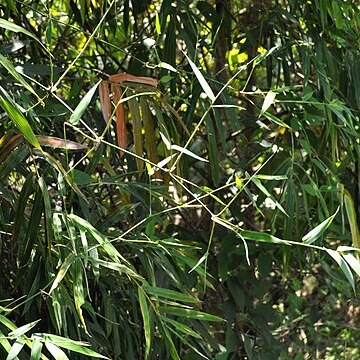Culms 15–24 m, 8–15 cm in diam., apically nodding; basal internodes slightly flexuose, green, 25–35 cm, distally initially sparsely strigose, later glabrous; wall 20–30 mm thick; each node of lower culm with a ring of aerial roots or root primordia, with a gray or brown sericeous ring below and above sheath scar. Branches to base, solitary on lower nodes, with branchlets usually forming tough, sharp, curved thorns and densely interwoven. Branches 3 to several on upper nodes, central markedly longer and thicker. Culm sheaths tardily deciduous, apex broadly convex or concave, with a triangular protuberance on each shoulder, densely stiffly brown hairy; auricles usually reflexed, crescent-shaped, linear-oblong, slightly unequal; oral setae dense, pale brown, curved, long, thick; ligule 4–5 mm, laciniate, fimbriate; blade usually reflexed, ovate to narrowly ovate, abaxially strigose, adaxially densely stiffly dull brown hairy, base ca. 2/5 as wide as sheath apex, margins ciliate. Ultimate branches with 5–9 leaves; leaf blade linear-lanceolate to narrowly lanceolate, 10–20 × 1.2–2.5 cm, both surfaces scabrid, mainly subglabrous but abaxially densely villous near base. Pseudospikelets 2 to several, clustered at nodes of flowering branches. Spikelets pale purple-green, linear, 2.5–4 × 0.3–0.4 cm; florets 4–12, central 2–5 perfect. Glumes 2, ca. 2 mm, glabrous; lemma ovate-oblong, 6–9 × 2.5–4 mm, glabrous, 9–11-veined, margins glabrous, apex acute; palea ca. 7 × 1.8 mm, 3-veined between and 3-veined on either side of keels, apex bifid. Filaments separate, 6–7 mm; anthers yellow, 3–4 mm. Ovary narrowly ovoid, 1.2–2 mm; style short; stigmas 3. New shoots Jun–Sep, fl. spring.
More
A spiny tufted bamboo. It grows up to 25 m high. The stems are 20 cm across. The internodes are usually hollow and from 40 to 60 cm long. The lower internodes are so thick walled they are almost solid. It grows in large clumps and the lower portion to 2 to 3 m is interlaced with spiny branches. The stems are smooth and green. Branches arise from the nodes. The culm sheath is 30 cm long by 22 cm wide. The back is covered with stiff hairs. The leaf blade is narrow and sword shaped. It is 15 cm long by 1.5 cm wide. Young shoots have yellowish green sheaths and blades. Plants flower very rarely. It may only flower every 20-30 years. The plants die after flowering.

